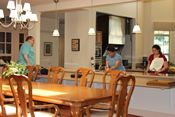Category: Customer service
Posted by Dr. El - June 30, 2014 - Customer service, McKnight's Long-Term Care News, Money Issues, Tips for gifts, visits

Here’s my latest article on McKnight’s Long-Term Care News:

It was noon at the nursing home and the staff was busy wheeling residents into the dining room. “Are you going to buy me lunch today?” an aide joked as she unlocked the brakes on Mr. Romano’s wheelchair. He smiled, but I could tell he was pained. He’d just spent his last psychotherapy session discussing his now-meager funds after a lifetime of earning and saving.
In my conversations with hundreds of long-term care residents over the years, I’ve found money to be an almost universally sore subject among them. Since money is a primary concern for most of us throughout our adult lives, it should come as no surprise that financial concerns continue to be a stressor for our residents even though they’re living in the mostly money-free society of LTC. The reasons for this financial tension vary, and with some adjustments we can reduce aspects of our residents’ financial distress.
Money stress sources and remedies
• Spending down: Residents who saved money during their lives and are now spending their savings to qualify for Medicaid are particularly sensitive to, shall we say, variations in care.
“This is what I’m paying for?” they’ll ask with incredulity at an unpalatable meal or an unpleasant interaction with a staff member. It’s a bitter pill to scrimp all one’s life and have to pay out of pocket for healthcare with savings, particularly when the lifelong free spender in the next bed is getting exactly the same care paid for by Medicare and Medicaid.
Remedy: While we can’t change the fact of the spend down (and it should go without saying that we provide the best service possible to every resident at all times regardless of their funding source), we as experts can offer suggestions for spending down that allow residents to make the most of this period.
o For example, elders might want to buy a television set, some extra clothes and other belongings they’ll be able to enjoy once they’ve qualified for Medicaid and don’t have as many funds to access. Perhaps they’d like to buy themselves flowers or fruit that arrives monthly for the next year so that they have some luxury in their lives when things get tight. New residents and families have never spent down before and they need our advice about what’s permissible and likely to make them happy in the years to come.
o Residents may be legally allowed a financial gift to a family member who can then use that money for them at a later point.
o Encourage seniors to put aside money for a burial fund, if needed, so that they don’t have to worry about this later in life. Money for burial isn’t counted toward the maximum amount residents are allowed to hold in their personal accounts.
• Personal Needs Allowance (PNA): Residents are entitled to a monthly PNA that allows them to buy things such as clothing, haircuts, special trips and other items not provided for by the facility. Unfortunately, when this amount — which varies by state — was determined back in 1980, no provision was made for inflation. In New York, the $50 PNA from 1980 is now worth $17.32. If the PNA had been adjusted for inflation, the resident would be getting $144.36 each month, which is a reasonable allotment that would permit people to buy the aforementioned goods and services, plus some takeout food or an occasional gift for their grandchildren. Managing personal needs on $50 a month in 2014 is beyond challenging. (For more on this, see the Money Issues anecdotes at My Better Nursing Home and the “Your Money” chapter of The Savvy Resident’s Guide.)
Remedy: Clearly, PNA levels should be adjusted for inflation, but for now we can help residents living on a very tight budget in several ways.
For the entire article, visit:
For a humorous take on one resident’s efforts to manage her money, click on Aunt Sylvia Spends Down (http://youtu.be/5ZpdhO9HNmc) or watch below.

Posted by Dr. El - June 12, 2014 - Business Strategies, Communication, Customer service, Engaging with families, McKnight's Long-Term Care News, Motivating staff, Resident care

Here’s my latest article on McKnight’s Long-Term Care News:

At the front desk, the workers were having an argument. Some residents watched the proceedings with interest and others with expressions of alarm. A waiting family member shifted from one leg to another and began sighing with exasperation as the loud conversation wore on without her presence being acknowledged.
We may talk about the term “customer service” and ask our staff members to avoid public arguments like the one above, but nevertheless, similar situations happen every day. Why does it matter so much? Using the model of the family as a guide, I discuss the psychological importance of good customer service in all our interactions.
With other staff members – Just as the relationship between parents forms the foundation of a family, our relationships with our coworkers are the foundation of good customer service.
o As shown in the above example, the residents observe how we treat one another. If our conversations are respectful and collegial, residents feel comfortable discussing concerns because they perceive their caregivers to be levelheaded and understanding. Angry, shaming interactions between staff members create an unsafe environment, making residents less likely to share information — including details that may affect medical care.
o Difficult interactions with coworkers are frequently transmitted to resident care. This is known in psychological terms as displacement. In the classic case, the boss yells at the father, who comes home and yells at his wife, who yells at the kid, who kicks the dog. If the nursing supervisor publicly criticizes the nurse who then chastises the aide, the residents are likely to be on the receiving end of the aide’s aggravation. Alternatively, if the nursing supervisor compliments the nurse who in turn praises the aide, the residents are more like to be met with a cheerful, upbeat caregiver.
o How senior staff members talk to subordinates is passed along to the next level of subordinates, not just through displacement, but also through modeling. Senior staffers are showing through example “how we handle things here.” When an administrator uses “teachable moments” to calmly point out what aspects of a crisis were managed well and what could be done differently for mismanaged parts, this becomes its own teachable moment in terms of how to provide constructive feedback.
For the entire article, visit:

Posted by Dr. El - May 15, 2014 - Customer service, Depression/Mental illness/Substance Abuse, McKnight's Long-Term Care News, Medication issues, Resident care

Here’s my latest article on McKnight’s Long-Term Care News:

“My mother was kicked out of her nursing home again,” my cousin told me. “They said they couldn’t handle her.” I phoned Cousin Belle’s new number in the afternoon.
“They didn’t give me my pain medication,” she said angrily. “They took away my walker and I need to use the bathroom. CAN SOMEBODY GET ME MY WALKER – I NEED TO USE THE BATHROOM!” She began sobbing. I heard another voice. “Did you hear what the man next to me just said?…You’re not a man?.. .I’m sorry, I can’t see…” Belle lost her vision several years ago, just like her father before her. “I helped people all my life,” she told her companion. Belle is a retired nurse.
She shouted again and I heard a staff member say, “Have some respect for the other residents.” Belle responded immediately, “Have some respect for me!”
“Let’s say the ‘Serenity Prayer,’” I suggested. “OK, let’s,” Belle agreed immediately. When we finished, she asked to say it again. She sounded calmer. “The woman next to me said it with me,” she remarked.
That story is about Cousin Belle, but it’s also the story of Gerry, Anna and a host of other residents I’ve seen over the years. Below are some suggestions for handling these challenging residents, coming from my perspective as a psychologist. I know there are many educated, experienced and compassionate people from other disciplines who will read this. If you have any additional tips, please add them in the comments section.
- Start afresh: If the current staff members are burned out and no longer responding well to the resident, it can be helpful to move the resident to a new unit or facility with a clean slate and fresh expectations. Notify the new team in advance so that they can prepare for the anxious resident and avoid repeating the same situation.
- Keep in close contact with the psychiatrist: The very anxious resident is likely to need medication for anxiety or depression, or at least to know that something is available if necessary. The early, frequent and regular attendance of the psychiatrist can reassure the resident and the team that an expert presence is guiding care.
- Give meds quickly: If residents are in pain or on a medication upon which they’ve become dependent, give the medication as soon as possible. Waiting will only increase their agitation and disturb other residents.
- Mollycoddle: A loud and anxious resident is likely to become louder and more anxious the longer they have to wait for their demands to be met. Just like with the medication, attend to their needs as soon as possible. Anxious people tend to be anxious because they feel out of control. Meeting their needs helps them feel more in control.
- Assign your most patient and compassionate aides: Satisfying a very anxious resident’s demands can be a never-ending task. Try to assign the type of person who will approach each call for assistance with a pleasant demeanor and not those who will let their displeasure be known with an unkind word or expression.
For the entire article, visit:

Posted by Dr. El - April 21, 2014 - Business Strategies, Customer service, Depression/Mental illness/Substance Abuse, Resident care, Talks/Radio shows, Younger residents

Join Dr. El this Thursday in Connecticut!
The Connecticut Association of Health Care Facilities
is sponsoring a talk on
Meeting the Needs of Younger Residents
Thursday, April 24th, 2014 at 9am
at the Crowne Plaza Hotel in Cromwell, CT
For more information and to register: CAHCF.org

Posted by Dr. El - March 20, 2014 - Business Strategies, Customer service, Inspiration, McKnight's Long-Term Care News, Resident care, Something Good About Nursing Homes

Here’s my latest article on McKnight’s Long-Term Care News:

In my last post, I discussed culture change and its positive impact on the mental health of the residents, particularly at Eden Alternative facilities. I recently also had the opportunity to tour a Green House, which I’d heard about but had never seen. While Eden Alternative homes change the culture of care within existing facilities, The Green House Project creates the “ideal” setting from the ground up.
The template of a Green House is a small building that is home to 10 to 12 residents, or “elders,” and two caregiving “Shahbaz,” which is the plural of Shahbazim. A Shahbazim is an aide trained to do almost everything that needs to be done within the house – providing care for the elders, laundering the clothes and bedding, performing light housekeeping, planning meals, cooking, serving the food, engaging the elders in activities, etc.
The house itself is designed to be more like a home, with private rooms off a large common area that includes a living room, dining area and kitchen.
I found this model turned everything I’d known about nursing homes upside down.
Green Hill visit
The first thing I noticed when I pulled up to Green Hill in West Orange, NJ, aside from the impressive entrance to this former hotel, was that there were parking spots reserved for visitors. By contrast, most of the nursing homes I’ve encountered have reserved spaces for upper level staff. This easily replicable idea offers a person-centered approach even before guests enter the facility.
Green Hill has four Green Houses in addition to its other levels of care. Ten elders reside in each of these small buildings in the back of the campus.
Walking into the Green House was very much like entering someone’s home. As I came through the entryway, there was a small, bright room on my left where I later interviewed one of the elders. On my right was a large, open kitchen. A computer monitor was discreetly tucked in the corner next to a glass cake stand holding a freshly baked cake.
For the entire article, visit:
For more on The Green House Project, visit their website.

Green Hill dining area and kitchen
Posted by Dr. El - January 2, 2014 - Anecdotes, Customer service, Role of psychologists

Here’s my latest article on McKnight’s Long-Term Care News:

Many of us in long-term care think of our jobs as a calling. We handle the day-to-day tasks and the business as usual but also get a lot of energy and joy out of taking our work one step further. Here are some actions I’ve taken that have enriched my patients and my role as a psychologist.
1. Set up Facebook accounts so residents can stay connected with their friends and family members.
2. Searched through their charts to find out the outcome of a medical consult.
3. Followed up with the nurse if the recommended course of action wasn’t pursued.
4. Cleaned out messy closets and drawers to give the resident some sense of control.
5. Searched for missing items (and found 90% of them!).
6. Attended one patient funeral early on in my nursing home career, where I sobbed from the moment I entered the room until the moment I left. Never again have I gone.
7. Tracked down and reunited missing family members.
For the entire article, visit:

Posted by Dr. El - December 12, 2013 - Common Nursing Home Problems and How Psychologists Can Solve Them, Communication, Customer service, McKnight's Long-Term Care News

Here’s my latest article on McKnight’s Long-Term Care News:

“My roommate is driving me crazy with his oxygen machine. I haven’t slept in days.”
“Her husband stays in the room all the time, even when she’s in rehab.”
“She always leaves the window open and I’m freezing!”
These are some of the many complaints about roommates I’ve heard from residents over the years. While some roommate difficulties need to be addressed on a situation-by-situation basis, most conflicts revolve around a few basic issues.
Here’s a handy guide to conflicts and potential resolutions to print out and give to staff members involved in making room assignments.
• Temperature of the room: Have the person who likes it colder or hotter by the window/air conditioner/radiator so they are closest to the source. The temperature in the hallway will moderate the atmosphere around the bed near the door. Give extra blankets to those who like to be warm but have a roommate who likes it cool. Or change rooms so that people who like similar conditions room together.
• Noisy medical equipment: Someone with such needs might do better living with a hearing impaired roommate or a sound sleeper or being moved to a private room if it’s a temporary condition.
• Frequently visiting family members: While visiting hours have been expanded in many facilities, it doesn’t mean they need to take place in a resident’s room, especially if it’s disturbing to others. It may be necessary to distinguish between facility visiting hours and in-room visiting hours and to refer families to alternative locations for visits, such as a lounge. Family members can be directed to wait in common areas if their loved one is not in their room.
• Loud televisions: Setting a time (such as 10 p.m.) to lower the volume on TVs and to turn out lights that aren’t in use will help with sleep hygiene on the floors in general and will reduce conflict between roommates (because it’s “policy” and not personal). Those who want a loud television can use a headset or be moved to a room with a hearing impaired roommate.
For the entire article, visit:

Posted by Dr. El - December 4, 2013 - Business Strategies, Customer service, McKnight's Long-Term Care News

Here’s my latest article on McKnight’s Long-Term Care News:

“I hope Santa brings me a Sony DS,” my 7-year-old told me the other day. I can tell you right now that Santa is not bringing her a video game player, but I didn’t want to tell her that or spill the beans about Santa. So I did what I imagine most parents would do in that situation: I asked her what else she hoped Santa would bring.
There are many benefits of hope, according to an article in October’sAmerican Psychological Association Monitor. Researchers report that, “Hopeful people have a greater sense that life is meaningful.” In addition, “Hope is a strong predictor of positive emotions … and a necessary step on the path to contentment.”
Psychologists differentiate hope from optimism, saying that optimism is a feeling that generally good things will happen, while hope tends to be focused on more specific goals. Researchers state that social connections are an important part of being hopeful, counteracting the feeling of being invisible and alone.
Hope in LTC
So what does this have to do with long-term care? As it turns out, a lot.
The article referred to a 2001 study that examined the level of hopefulness of nearly 800 people aged 64-79. Several years later, 29% of those classified as hopeless had died, compared to 11% of those who were hopeful. Researchers note that hopeful people tend to make better health choices.
If hopeful residents are making better health choices, chances are they’re more likely to comply with medical recommendations and dietary guidelines. They’re more likely to get up and go to rehab, increasing your reimbursement rates. Residents who are hopeful, happy, and satisfied are more likely to refer people to your facility.
Helping residents feel hopeful
Residents often enter our facilities after a demoralizing health problem. They may be cut off from their usual support system and worried or fearful about the future. We can help our residents feel more hopeful by implementing the following ideas:
1. A warm welcome from staff: First impressions really are important. Make sure their initial welcome feels personal and reassuring, reducing their feelings of being invisible and alone. I’ve watched new residents being pushed through the doors in stretchers or wheelchairs. The “pusher,” usually an ambulette driver, consults with the security desk for a room number while the resident is ignored.
Instead, train your staff, especially those at the front desk and those who will greet admissions on the floors, to make eye contact with each new person, smile and say, “Mr. Johnson, welcome to My Better Nursing Home.”
2. A friendly greeting from peers: While staff members can provide important information and reassurance for residents, hearing it from others who have been through the same thing is invaluable. A resident welcoming committee shows newbies that there are people who are happy in your facility, leading them to believe that they can be happy too. Residents also can give the lowdown on things staff can’t say, such as which staff members are grumpy and how to work around them.
For the entire article, visit:

Posted by Dr. El - November 14, 2013 - Business Strategies, Customer service, Engaging with families, McKnight's Long-Term Care News

Here’s my latest article on McKnight’s Long-Term Care News:

As the holiday season draws near, more families will be passing through your doors to visit their loved ones at your facility. Out-of-town relatives will be making annual trips and locals will be taking the children to see Grandma during school breaks. This is an ideal time to provide extra services that showcase your high level of care and make the season more pleasant for families and residents.
You’re the experts when it comes to eldercare – most of the families are going through this for the first time. Show your commitment to customer service by giving families the guidance they need to make the most of season.
Here are some ideas:
1. Provide info on planning time with loved ones
Let families know in advance not just about your visiting hours, but also about how to schedule passes home. Which staff members do they need to talk to about taking Grandma out of the facility? What arrangements should they make regarding transportation? Do they need to be giving medication and if so, what kind of training is required and who will be providing it and when?
Write this all down for them and put it on your website or newsletter and/or have an info sheet with holiday information at the front desk. Add an option to your telephone menu with frequently asked questions about visits and passes.
2. Suggest new rituals
People often have difficulty imagining ways to celebrate the holidays other than in the family tradition. They may need your help envisioning possibilities that take into account illness and a long-term care stay. If the family home isn’t wheelchair accessible, families can create new traditions such as enjoying an accessible local restaurant, or they can keep it simple and go out for a manageable coffee and dessert.
If Grandpa isn’t well enough to leave the facility for a celebration, suggest alternatives such as bringing food to him in his room or reserving a common area for an hour. Let families know your dietary staff is available to discuss appropriate foods and that the kitchen staff is ready to reheat leftovers or to puree or chop as needed. Suggest foods that are already pureed or chopped such as mashed potatoes or pureed soups to minimize the feeling of missing out on something.
3. Offer communication tips
For the entire article, visit:

Posted by Dr. El - October 17, 2013 - Customer service, McKnight's Long-Term Care News, Personal Reflections, Resident care

Here’s my latest article on McKnight’s Long-Term Care News:


I used to live in a fabulous old fourth-floor walk-up apartment in Manhattan. When I moved out of Manhattan to a borough of New York City for an elevator building with a laundry room in the basement, I made a conscious choice to pick a place I could live for the rest of my life if I had to. That ramp could come in handy if I need a wheelchair, I reasoned. And if worse comes to worse, I’ll move into a nursing home and blog from there.
A lot of residents tell me, “I never thought this (living in a nursing home) would happen to me.” After hundreds of these conversations, I have the opposite approach. I figure, “Why not me?”
But actually, I wouldn’t want to live in any of the nursing homes where I’ve worked. Sure, if I had to, I’d make do. I’d rabble-rouse and kvetch and roll to the administrator’s office if the situation called for it. I’m ready for a fight.
That was my thinking until last week when I toured the eldercare home of my dreams.
For the entire article, visit:
.





















